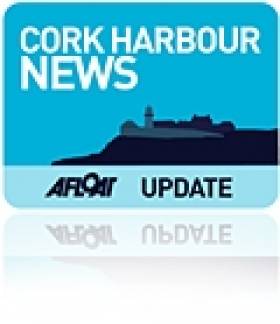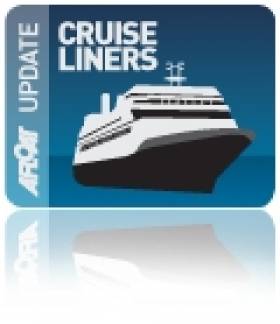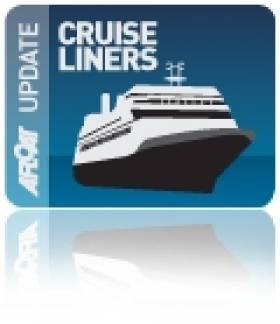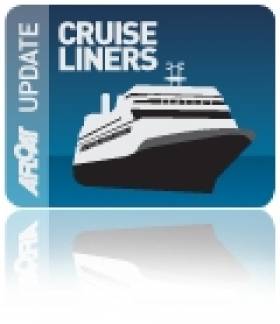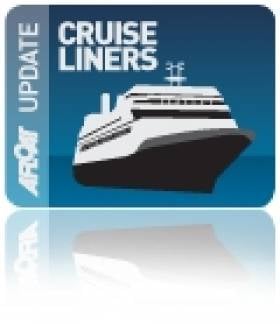Displaying items by tag: Cobh
Cruise Caller Line-Up for Galway Harbour
#CRUISE LINERS- Galway Harbour can look forward to welcoming nine cruise calls to the mid-west port this year, with the first visitor being Arion which is scheduled to arrive in Galway Bay during late May, writes Jehan Ashmore.
Arion harks back to an era of the more classically designed ships with graceful sweeping lines. The 5,888 tonnes veteran vessel was launched in 1965 at Pula, in Croatia, as Istra and later in her career she underwent a major reconstruction in a Lisbon shipyard during 2000.
Cruise & Maritime Voyages (CMV) will be sending their Marco Polo, another classic veteran, in July as part of a 12 night 'Emerald Isle' discovery cruise departing Tilbury, with en-route calls to Cobh and Glengariff the previous day.
For a full listing of the cruise-calls schedule click HERE.
Coastguard Takes Delivery of New Chopper
#COASTGUARD - The Irish Coast Guard has taken delivery of its new search and rescue helicopter at its Shannon base, The Irish Times reports.
As previously reported on Afloat.ie, Sikorsky completed production of the new S-92 helicopter for the Irish Coast Guard last December under the rescue service's €500 million deal with CHC Ireland to revamp the aircraft fleet.
The deal will also see the coastguard's remaining four Sikorsky S-61s replaced by second-hand S-62s from Scotland over the coming months.
Training with crews at Shannon is set to begin shortly ahead of the S-92's first public demonstration at the centenary of the Titanic’s departure from Cobh in Cork Harbour.
Meanwhile, it is expected that the Air Corps may be offered an upgraded air ambulance role, after they were ruled out as contenders for search and rescue work amid some controversy.
The Department of Health has reportedly been in exploratory talks with private firms regarding the provision of an inter-hospital emergency air transfer service, as called for by the Roscommon Hospital Action Group.
The Irish Times has more on the story HERE.
Cove Salute Media Couple for 'Contribution to Sailing'
#CORKSAILING – Cove Sailing Club's annual prizegiving hosted by Commodore Derry Allister was held with a certain vibrancy at the weekend. Members are buoyed up with the news that its new Junior section at Whitepoint has recruited 152 members, a great boost to sailing in Cork Harbour. The Cobh club is pressing ahead too on its own marina plans, another big area of progress for marine leisure berthing in the harbour.
Earlier this year Cove Sailing Club was granted full planning permission for a 74 berth marina (including visitor berths) at Whitepoint. The proposal being developed is that Cove Sailing Club shall develop and manage the marina in order to provide facilities for use by club members and visitors to Cove.
This year's laying up supper was held at the Commodore Hotel in the seaside town. Members met in the downstairs bar before heading for the Jack Doyle room for lay-up dinner and prizegiving.
There were plenty of annual prize winners from the season of club events (SEE PHOTOS BELOW). Sailing Correspondent and Photographer Claire and Bob Bateman of this Parish received special mention for their work in promoting sailing in the harbour.
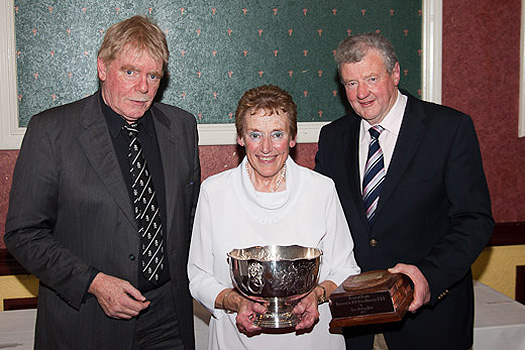
Cove Sailing Club Commodore Derry Allister (left) presents Sailing Journalist's Claire and Bob Bateman with the Foley Rose Bowl
The Bateman's were presented with the Foley Rose Bowl trophy. The trophy was first presented to Cove Sailing Club in 1974 when the late Bryan Foley was Chairman of the Cork Harbour Commissioners. It has many illustrious names on it and is awarded on merit, to the class, club, boat, person or group who have in the opinion of Cove Sailing Club contributed significantly to the promotion of sailing in Cork Harbour.
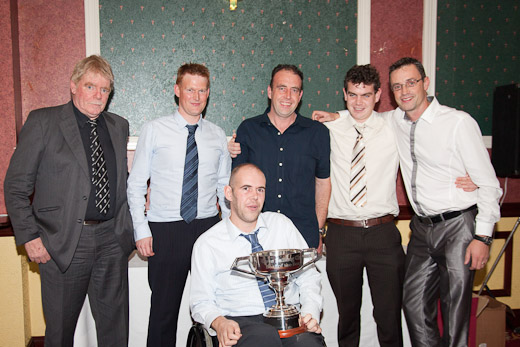
Boat of the year No Half Measures - Finbarr Dorgan (with trophy) and with Derry Allister crew (L-R)Kieran and Gareth Dorgan, Hal Courtney andRichard Marshall. They also won the overall Friday Night League for Kites IRC division.
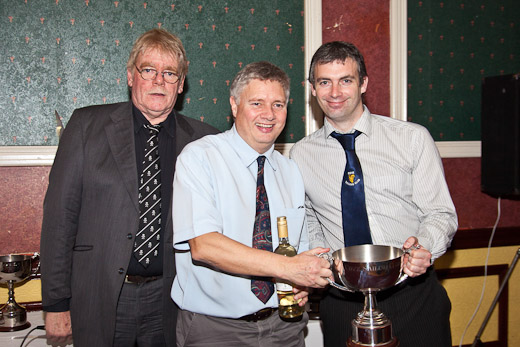
Damian Aherne, skipper of Re Eile being presented with the September league IRC trophy for class 3. Derry and Brendan Ryan (Sailing Secretary) in
background
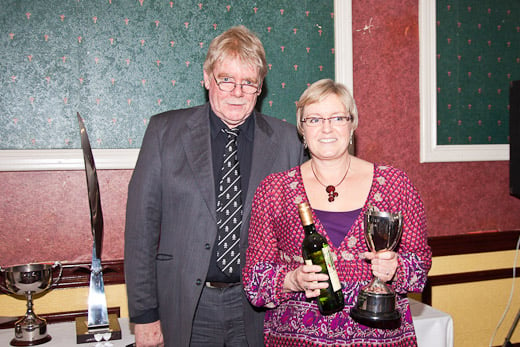
Ann Aherne being presented with the September League Echo trophy for class 3
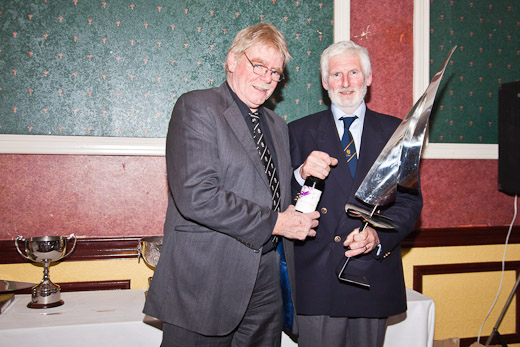
John Doyle, Chanteuse presented with the Friday Night League Whitesail trophy
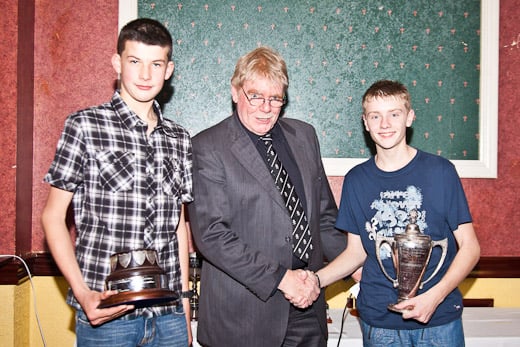
Dave Marshall and Rob Scandrett receiving the Ballinacurra Cup

Club Person of the year Brendan Ryan (Sailing Secretary)
Photo Exhibition: People of the Sea / Gens de la Mer
Gilles Perrin selected his subjects by visiting harbours and piers in locations such as Cobh, Baltimore, Castletownbere and Schull. The work was conducted through the Artist in residency programme at Sirius Arts Centre, Cobh and later by a similar residency position at the West Cork Arts Centre which took place over a few months in 2007 & 2008.
People of the Sea is organised in partnership with Veolia Environnement, also the name given for a new MOD70 class (Multi One Design). Veolia Environnement is one of only 12 such high-spec performance yachts which visited Dublin Bay in the summer calling to Dun Laoghaire and a transit of Dalkey Sound (PHOTO's). She was in Irish waters under the skipper Roland Jourdain and crew ahead of her first test, the Fastnet Race held in mid-August. To read more about Veolia Environnement click HERE and also www.canyousea.com/en/
The other participants of the exhibition which have lent their support are the Sirius Arts Centre, The Arts Council, Cork County Council and The West Cork Arts Centre, and iophotoworks. For more information about Perrin who has a master's Degree in photography visit www.art-contemporain.eu.org/perrin/
- Schull
- Baltimore
- Cobh
- castletownbere
- Dublin Bay News
- Dun Laoghaire Harbour
- Fishing News
- Cork County Council
- Sailing news
- Dalkey Sound
- Veolia Environnement
- French Photographer Gilles Perrin
- Gilles Perrin
- People of the Sea/Gens de la Mer
- Alliance Francaise Dublin
- French Cultural Centre Dublin
- Irish Fishing Harbours
- Sirius Arts Centre
- The Arts Council
- West Cork Arts Centre
- The Fastnet Race
- MOD70 class
- Multi One Design
- Irish Fishing Industry
- Roland Jourdain
Queen Elizabeth's Chartered Cruiseship on Three-Day Visit to Dublin
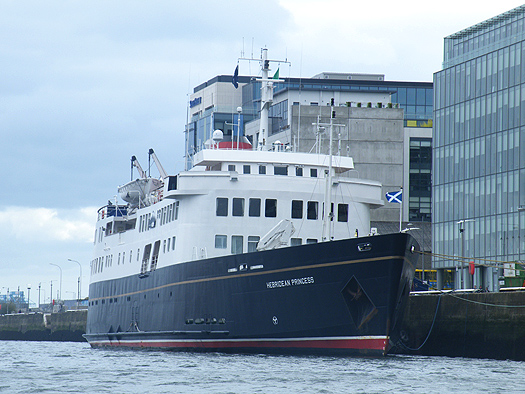
Operated by Hebridean Island Cruises, the 5-star vessel which is for only 50 guests, has a reputation for exceptional service, fine dining and has a crew of 38. Accommodation is in thirty spacious, elegant and well-appointed cabins. On Princess Deck is located 'The Isle of Arran' (for deck plans click HERE) Suite which at 340sq ft is the largest and most expensive. The suite comprises a large separate dayroom, a spacious bedroom and a luxuriously equipped Victorian-style marble bathroom. In addition 10 cabins are designed especially for the single traveller. She has appeared in 1st place in UltraTravel Magazine's "10 Coolest Cruises"
Normally the Glasgow registered vessel operates throughout the Scottish highlands and islands, to lochs and remote mainland locations made accessible due to her small size. It is in these same waters that the Hebridean Princess has sailed in another guise as the humble car-ferry Columba (photos) for Caledonian MacBrayne. She was built in 1964 by Hall Russell, Aberdeen and served in this role until 1989 when she was sold and underwent an extensive conversion for the ultra-luxury cruise market.
Her three-day stay to Dublin is part of a Grand Celtic Cruise which started in Cardiff and which will include a call to Carlingford Lough tomorrow, followed by Strangford Lough, Bangor, Ballycastle, the Scottish isles of Jura and Crinan before disembarking in Oban, her home-port. The 10-night cruise inclusive of three-gala dinners cost €4,195 per person for a double cabin and €6,292 per person in a single-cabin.
A decade before Columba was launched, the Royal Yacht Britannia (5,682 tonnes) was commissioned in 1954. She was laid-down two years previously at John Brown & Co. Ltd, Clydebank and the year before she entered service she was launched by HM Queen Elizabeth II. For over four decades she served as the royal yacht until decommissioned in 1997. Her final foreign mission was to convey the last governor of Hong Kong and Prince of Wales from the former colony after its handover to China. She is now permanently moored as an exhibition ship in Edinburgh (Leith) for details click HERE.
Earlier this month Queen Elizabeth's namesake the 2010 built Cunard Line cruiseship Queen Elizabeth made her maiden Irish call to Dublin followed by Cork (Cobh). To read more on Dublin call click HERE and for Cork (Cobh) click HERE.
- Dublin Bay
- Dublin Port
- Dublin Docklands
- Cobh
- Cruise Liners
- Ports and Shipping
- Queen Elizabeth II
- Cruiseships
- Cunard Line
- The Convention Centre
- Cruise news
- Hebridean Princess
- Hebridean Princess Cruises
- Columba ferry
- Caledonian MacBrayne
- Hall Russell Shipyard
- Royal Yacht Britannia
- Hong Kong handover
- Prince of Wales
- Royal Yacht
Cunard Line Flagship Queen Mary 2 Calls to Cobh
The current liner (QM2) can carry 2,620 passengers and a crew of over 1,200 on a vessel is the longest, tallest and widest of any passenger liner built. The luxury liner has private balconies for nearly 80 per cent of cabins and has an art collection worth £3.5m. To complement these works of art there is the first 'floating planetarium', the largest library at sea, boasting 8,000 hardbacks and also the largest ballroom to grace a ship on the oceans.
Queen Mary 2 was short-listed to be built in Belfast at the Harland & Wolff shipyard, but the contract went to Chantiers d'Atlantique, St. Nazaire on the west coast of France.
Her first visit to Irish waters occurred when she anchored off Dunmore East in 2005, the liner had arrived overnight on a passage from her homeport of Southampton and was on a nine-day cruise of British, Irish and Baltic state ports.
Today's Cobh visit of the 345m long Queen Mary 2 coincided with Ocean Countess, a former 'Cunarder', which is also in the port. The 163m vessel was built in 1976 and launched as their Cunard Countess. She weighs 17,593grt and has a 800 passenger capacity. Last year she joined Cruise & Maritime Voyages (CMV) fleet under charter from Majestic International Cruises Group.
Also at work in Cork Harbour was the excursion vessel Spirit of the Isles which apart from operating River Lee sight-seeing cruises between Cork city-centre and Cobh at the weekends, is running a charter cruise this afternoon to Spike Island. For information about sightseeing trips and chartering click HERE.
Queen Elizabeth Arrives Exactly on Schedule
Despite the squally and blustery conditions, the 294m Cunard Line cruiseship was assisted by the tug Gerry O'Sullivan, was swung swing around in the turning basin off Cobh with the consumate skill of her master Captain Christopher Wells. She eased alongside the deepwater cruise berth fifty minutes later with the first mooring line cast off from the bow to an awaiting lines-boat at 09.00hrs, as exactly scheduled.
MV Queen Elizabeth Makes Maiden Call to the Port of Cork
The luxurious ocean liner, MV Queen Elizabeth will make her maiden call to Cobh tomorrow morning arriving at 9am and bringing with her over 3,000 passengers and crew. With a gross tonnage of 90,900 GRT and a guest capacity of 2,068 and 996 crew, MV Queen Elizabeth is the newest Cunarder to join the fleet.
To coincide with her maiden call, the Port of Cork together with Cunard will hold a Lusitania Memorial Service in the centre of Cobh town. Led by Captain Christopher Wells, this service will be attended by the Chairman of the Port of Cork, Port of Cork Directors, Mayor of the Town of Cobh, the County Mayor and the Lord Mayor. A number of other key figures have also been invited.
Cunard have a great history of calling to the Port of Cork and over the years all of Cunard’s liners have made a visit to Cobh. This year is the first year to welcome all three queens; Queen Mary II, Queen Victoria and Queen Elizabeth to Cobh. In 2009, MV Queen Elizabeth II made her final call to Cobh before departing for Dubai where she was to become a floating hotel.
The following will be read at the Lusitania Memorial Service, by Captain Michael McCarthy Port of Cork;
The sinking of the Lusitania on 7th May 1915 was a human catastrophe on a scale that this small town had not experienced before or since.
When the Lusitania left New York there were 1,962 people on board, 694 crew,1,265 passengers and 3 stowaways. Only 764 people survived – 474 passengers and 290 crew. Over 800 of the victim’s bodies were never found. The bodies landed in Cobh were buried in 3 mass graves in the “Old Church Cemetary”.
The People in Queenstown, Cobh, witnessed the trauma, tragedy and heartbreak that ensued. The dead, the injured and the bereaved were brought among a community here that mobilised itself and responded with courage and compassion to their needs. One of the survivors, Charles Lauriat, later referred in his book “The Lusitania’s Last Voyage” to the streets filled with people ready to do anything in their power to relieve our sufferings. He said he had never seen anything more spontaneous or genuine or more freely given than the Irish hospitality of Queenstown.
This memorial reflects the eternal connection between Cobh, the” Lusitania” and Cunard, and is a stark reminder of the tragedy of war.
It is fitting that today Captain Christopher Wells of Cunard’s vessel “Queen Elizabeth” should be here together with the Mayor and people of Cobh to reflect on the great loss and the human tragedy of the “Lusitania”.
Queen Elizabeth: 73 years ago, Cunard’s first “Queen Elizabeth” entered service. The launching of that ship was described as “the inception of a great human enterprise, an act of faith”. Could they have imagined the design and capability of the current vessel berthed at the Cobh Cruise Berth?
In October 2008, Cunard announced the building of this magnificent vessel at an estimated cost of €500 million euros, and within 2 years the naming ceremony was carried out in Southampton by Her Majesty Queen Elizabeth 11,. The vessel departed on her Maiden voyage under the command of Captain Chris Wells on the 12th October 2010 .She has already completed a World voyage, transited the Suez and Panama Canals and crossed the World’s Oceans.
Captain Wells has already served a long and distinguished career in the Merchant Navy and following many years in command, was in 2008 appointed Master of the Queen Mary 2, the same year the QE2 was retired from the Cunard Fleet. He was subsequently appointed the first Master of the Queen Elizabeth in 2009
Port of Cork to Mark Maiden Arrival of MV Queen Elizabeth
On Saturday 10th September 2011, MV Queen Elizabeth will make her maiden call to Cobh in the Port of Cork. To coincide with this visit the Port of Cork will formally present a plaque to the Captain of the Queen Elizabeth on the quayside at 10.30am.
This will be followed by a Lusitania Memorial Service led by the Captain and Chairman of the Port of Cork at the memorial in Cobh Town.
Saturday 10th September 2011
0900hrs - MV Queen Elizabeth arrives in Cobh
1045hrs – Plaque exchange with Port of Cork and Cunard
1115hrs – Lusitania Memorial Service Begins in the centre of Cobh Town
1145hrs – Memorial Service Ends
1145hrs – 1245hrs – Band 1 Southern Brigade will play in the promenade in Cobh
Cruiseships Head for Cobh in advance of Queen Elizabeth
The 2,500 passenger Jewel of the Seas has a nine-deck centrum which has glass lifts which allows light to flow throughout the spacious and airy ship. Activities range from golf to climbing, a spa and sumptuous restaurants.
When the 2004 built cruiseship docks at the dedicated cruise berth at Cobh in the early hours of tomorrow she will also be sharing the deepwater berth with the 2001 built Silver Whisper. The ultra-luxury vessel accommodates only 388 passengers and is operated by SilverSeas Cruises. To read more about the vessel click HERE.
Both vessels are scheduled to depart Cobh around teatime tomorrow and this will be followed by preparations of the picturesque town which is to welcome the maiden call to Cobh of Queen Elizabeth on Saturday. To read more about the newest vessel of the Cunard Line fleet click HERE. The 2010 built vessel will firstly make an inaugural call to Dublin on Friday prior to the Cobh call which coincides with Cork Harbour Open Day, for event details visit www.corkharbour.ie




























